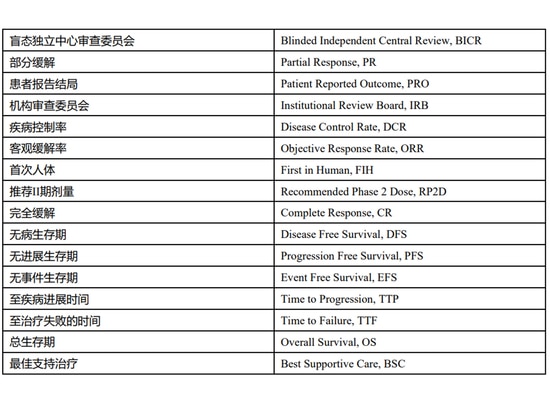
#Industry News
Interpretation of the Endpoints of Clinical Research Efficacy of Antineoplastic Drugs
The most commonly used efficacy endpoints in clinical trials of antineoplastic drugs include overall survival (OS), objective response rate (ORR), and progression-free survival (PFS) and patient Reported Outcome (PRO).
1. Overall survival (OS)
Overall survival was defined as the time from randomization (or start of treatment in single-arm trials) to death from any cause. OS is relatively objective and precisely measurable, and it is the most reliable end point for measuring the clinical benefit of anticancer drugs in randomized controlled clinical trials.
Advantages: It is widely used and recognized clinical benefit endpoints, based on objective and quantitative, accurate and easy to measure and evaluate.
Disadvantages: 5-year survival is often used in clinical trials, often requiring large samples and longer follow-up. The study results may be affected by crossover and subsequent treatment, and the inclusion of non-tumor deaths in the study results will also affect the accuracy of the results.
2. Objective Response Rate (ORR)
For many tumor types, disease assessment can be performed directly using tumor imaging, and treatment strategies for subjects are often based on tumor measurements and clinical symptoms. The objective response rate refers to the proportion of patients whose tumor volume shrinks to a predetermined value and can maintain the minimum time limit according to the recognized response evaluation criteria (such as Solid Tumors RECIST version 1.1). It is the most common endpoint based on tumor measurement. The response of solid tumors can be complete response (CR) or partial response (PR), and there are some other evaluation criteria for the evaluation of non-solid tumors. Using ORR alone may not be able to adequately describe the antitumor activity of the experimental drug [2], so it is necessary to descriptively analyze the duration of response (that is, the time from initial tumor response to disease progression or death from any cause, whichever occurs first) and time to remission. For drugs that benefit patients clinically by stabilizing the disease condition, the Disease Control Rate (DCR) can also be analyzed. This indicator not only considers the cases of disease remission, but also includes the cases in which the disease maintains a stable state for a certain period of time.
Advantages: It usuallyrequires smaller sample size and shorter follow-up time. The curative effect is attributed to the drug, and the exclusion of the natural course of the disease is usually based on objective and quantitative assessment, which is more suitable for enrichment population trials.
Disadvantages: The biggest disadvantage of ORR is that the efficacy of ORR may not be converted into survival benefits, and frequent imaging assessments are required during the evaluation of ORR, and ORR is not a direct measurement of the clinical benefit of drugs. Moreover, using ORR alone may not fully describe the antitumor activity of the experimental drug, so it is necessary to descriptively analyze the duration of response (that is, the time from initial tumor remission to disease progression or death from any cause, whichever occurs first) and to response time.
3. Progression free survival (PFS)
Progression free survival was defined as the time from randomization (or treatment initiation in single-arm trials) to tumor progression or death from any cause, whichever occurred first. Endpoints similar to PFS also include disease free survival (DFS), which refers to the time from the start of randomization (or the start of treatment in a single-arm trial) to disease recurrence or death from any cause (whichever occurs first) standard), and is mostly used to evaluate adjuvant therapy after surgical treatment or radiotherapy. Event free survival (EFS) is defined as the time from the start of randomization (or the start of treatment in a single-arm trial) to the first occurrence of any of the following events: disease progression beyond surgery, local or distant recurrence, any The cause of death, etc., is mostly used to evaluate neoadjuvant therapy before surgical treatment or radiotherapy.
Advantages: It usually requires smaller sample size and shorter follow-up compared to OS. Studies are usually based on objective and quantitative assessments, which are not affected by crossover and subsequent treatment, and have higher reliability.
Disadvantages: PFS is highly correlated with OS, but again may not translate into survival benefit. PFS assessment requires frequent imaging assessments, with possible assessment bias. More importantly, the PFS results will be affected by the assessment interval, and the definition and censoring rules of PFS may also be different between different trials, so it needs to be clearly defined in advance.
4. Patient Reported Outcome (PRO)
Patient-reported outcomes are reports directly from patients about their symptoms, health-related quality of life, treatment adherence, and satisfaction with treatment. Although it is more and more common to collect PRO data in clinical trials of anticancer drugs, there are still many problems in the evaluation of such measurement indicators, such as the reliability, validity and responsiveness of the scales used. In addition, PRO measurement [3] indicators are also susceptible to missing data, and appropriate methods should be used to deal with missing data. To better understand the relevance of trial results, it is recommended that PRO be explored in relation to other efficacy endpoints.
References
[1] "Guidelines for Statistical Design of Clinical Trials of Antineoplastic Drugs (Trial)" 2020 Edition
[2] Clinical cancer research, 2005, 11(21): 7872-7878.
[3]ICH. E9 (R1) Addendum on estimands and sensitivity analysis in clinical trials to the guideline on statistical principles for clinical trials. 2019





